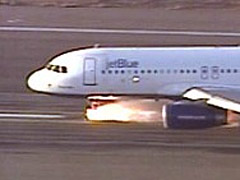 |
 |
 |
 Travel & Outdoors | September 2005 Travel & Outdoors | September 2005  
Great Video, But Little Danger in Emergency Jet Landing
 John J. Nance - ABC News John J. Nance - ABC News


| | A JetBlue airliner made a dramatic emergency landing after pilots discovered that the landing gear in the nose was turned sideways. (Photo: ABCNEWS.com) |
In many respects, the picture-perfect emergency landing of a JetBlue Airbus recently at LAX crossed a very odd dividing line between virtual and hard reality. By the time the calm, professional pilots at the controls of the A320 settled in on final approach, not only were we riveted by the amazing TV shots from helicopters and cameras on the ground - so were the very people involuntarily thrust into the middle of the drama: the passengers themselves.

Thanks to JetBlue's satellite television system, which features monitors nestled in each passenger's seat back, the passengers aboard JetBlue 292 had only to flick on CNN or FOX to see themselves in living color, flying, turning and finally landing - complete with a burst of flame as the sideways nosewheels disintegrated.

But, as is often the case with aviation, there were as many major misconceptions as television news helicopters covering the story, and the situation became more confused as the A320 came to a safe halt on the runway.

'Heroic' Isn't the Word

Yes, I know. There were smoke plumes and flames. And before that there were scary pictures of a jetliner in flight with a nosewheel cocked 90 degrees to where it should be - which is not the most comforting way to begin a flight to New York (where Flight 292 was initially bound). There were even a few reporters who opined that perhaps the plane would jerk itself off the runway when the nosewheel touched down, or would go tumbling into the weeds as it rolled and shed engines and parts.

That wouldn't have been a difficult fiction to sell. We are, after all, a rather voyeuristic society thoroughly desensitized by disaster movies featuring endless crashes of trains, planes and automobiles - not to mention relationships. And as a fiction thriller author, I've written my share, too.

But yesterday no one needed to work hard to ratchet up the tension. The dramatic television pictures and the wait for the crew to make its final approach to landing did a very effective job, and everyone was on the edge of their seats.

Meanwhile, back in the cockpit, the crew was doing a very competent, professional job.

Whoa. Just competent and professional? Not heroic? Wasn't this a feat of amazing airmanship and determination, yanking a crippled airliner from the jaws of certain disaster to save the day?

Sorry. No. Routine. We train for this, and a lot more.

In fact, the possibility that anything serious might happen on the landing was less than 1 percent, especially after the crew had done such a thorough job of preparing itself and the aircraft, discussing the problem with the company maintenance personnel and coordinating with flight attendants to work as a polished team.

Good Pilots, But Good System, Too

A modern airliner has what we call "tricycle landing gear," which means, among other things, that it can be landed easily and safely with the nose gear retracted, missing or even cocked. As long as the pilots have both main gear down and locked, and have the ability to control direction on the runway by using differential braking (if she's drifting left, push the right brake harder), and, as long as the hydraulic flight control systems are operating, the chances of even drifting off to one side of the runway before getting stopped are minimal.

The technique in this kind of landing has been well-established: Keep the nose up slightly after the main wheels are on the deck, until a significantly slower airspeed is reached (around 65 to 75 knots). Then the pilot gently "flies" the nosewheel onto the runway (you don't let it just plunk onto the surface).

Nose tires cocked 90 degrees are going to simply act like a brake. The friction helps the pilots slow while producing a column of smoke as the rubber burns away. When the tires are essentially gone, the metal of the wheel rims and the axle itself will start scraping away at the runway, but by then, as the pilots press hard on both main brakes, the speed will be diminishing rapidly. As long as the fire department is nearby to guard against any sustained flame from the heated metal of the nose strut, there won't even be a need to do an emergency evacuation.

Maybe not all of us in commercial cockpits would have stopped the aircraft so perfectly with the stub of a nosewheel resting squarely on the runway centerline (a really great job), but most pilots would have followed the same script.

What you saw Wednesday is a living example of why commercial aviation is so incredibly safe: the presence of a robust safety buffer. Even when something goes very wrong, we can not only successfully compensate, but do it with practiced predictability.

Bravo to the crew of JetBlue 232, but bravo to the airline safety system as well. | 
 | |
 |



